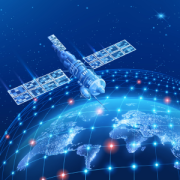This Advisor series examines on-orbit data centers, which are satellite- or station-based computing platforms that store, process, analyze, and relay data directly from space assets. In essence, they serve as edge computing nodes in orbit — reducing dependence on Earth-based systems and enabling AI-driven, real-time decision-making for autonomous spacecraft. Here in Part I, we delve into the rise of on-orbit data centers, focusing on how advances in edge computing, orbital networking, AI-powered infrastructure, and space-hardened hardware are set to transform the way we process and disseminate space-derived intelligence.
Key Functionality, Features & Benefits
On-orbit data centers can ingest data from satellites, scientific instruments, or inter-satellite links. Key functionality includes the ability to:
-
Process and analyze data locally (i.e., on board satellites) using AI and machine learning (ML) algorithms
-
Share and disseminate findings and other observations via high-speed optical/laser or radio frequency (RF) links (i.e., traditional wireless communications) with other satellites and Earth-based operations stations
Although still widely used, traditional RF links are being replaced (or complemented) with optical/laser communication systems due to their much higher data rates, lower latency, and greater resistance to interference and jamming. This trend is fueled by the growing demand for AI-powered applications in autonomous satellites and spacecraft operations that require real-time data exchange and maximum bandwidth efficiency.
These key operational features impart a number of benefits to on-orbit data centers:
- Low latency — enables real-time analytics and autonomous responses, which are critical for time-sensitive space operations
- Enhanced security — keeps data off-planet, protecting it from terrestrial cyberattacks and natural disasters
- Energy efficiency — leverages continuous solar power and passive cooling from the vacuum of space to minimize energy use
- Sustainability — reduces reliance on Earth-based data centers, lowering land use and overall terrestrial energy consumption
- Bandwidth optimization — preprocesses data in orbit to reduce downlink transfer volumes and ease network congestion
- AI enablement — powers onboard processing of complex, compute-intensive AI and ML workloads in real time
Laser inter-satellite links enable high-throughput, low-latency data exchange across orbital satellite networks, enhancing coordination and responsiveness. Optical downlinks to Earth further enhance performance by alleviating RF congestion and bypassing the limitations of traditional communication bands, offering a cleaner and more scalable path for ground transmission.
AI and ML empower satellites to process and act on data autonomously, without waiting for ground-based analysis. This capability is critical not only for in-space operations but also for Earth-based services that rely on rapid responses to satellite-derived insights — such as emergency management, navigation, identification/tracking, weather forecasting, and agricultural monitoring. Other benefits afforded by on-orbit data centers include sustainability improvements around energy consumption/infrastructure and enhanced cybersecurity for satellite data storage and transfer.
Enabling Technologies
Beyond the optical communication capabilities enabling inter-satellite and space-to-ground laser links, the emergence of on-orbit data centers is being driven by breakthroughs in advanced hardware and software.
At the forefront are space-hardened computing systems — servers and components engineered to withstand cosmic radiation and extreme thermal conditions through protective shielding and advanced thermal management. Notable examples include commercial AI/ML solutions like the Spaceborne Computer-2, developed by Hewlett Packard Enterprise (HPE) and Nvidia, which brings edge-to-cloud AI capabilities directly to space missions.
Powered by high-performance AI accelerators such as Nvidia graphical processing units, these systems provide onboard, data center–level processing in space. Spaceborne Computer-2, for example, can ingest data from satellites, cameras, and other sensors, applying advanced AI to manage complex, compute-intensive workloads in real time. It has also been tested on the International Space Station.
Key Application Areas
We expect on-orbit data centers to transform various space application domains, including:
-
Autonomous space operations. Onboard data centers can enable real-time integration of multi-sensor and historical data to support autonomous spacecraft navigation, debris tracking/avoidance, and mission planning. They can also facilitate AI-driven fault detection and predictive maintenance in order to identify and resolve issues before they jeopardize mission integrity. Additionally, they can support autonomous decision-making for robotic servicing, including refueling, resupply, and in-orbit repair of satellites and space stations.
-
Earth observation and climate monitoring. This application area combines AI-powered onboard processing of hyperspectral and synthetic aperture radar imagery to detect potentially dangerous incidents and issue timely alerts for wildfires, floods, pollution events, and other environmental hazards. The goal is to significantly reduce response times and enhance environmental governance.
-
Defense and national security. As military and security operations increasingly depend on space-based assets, on-orbit data centers can facilitate real-time processing, exploitation, and dissemination of surveillance data. They also enable AI-enhanced threat detection and tracking to support tactical and strategic decision-making and operational readiness.
-
Space manufacturing and research. On-orbit data centers are uniquely equipped to support space-based manufacturing through AI-driven analytics and real-time data processing — enabling applications such as industrial crystal growth, materials science experiments, and in-space 3D printing of spacecraft components. They also offer robust data storage and analysis capabilities for microgravity research, including pharmaceutical development, advanced drug discovery, and bioprinting of human tissues and organs.
-
Interplanetary communications. Looking ahead, orbiting data centers will evolve into key computational hubs for lunar and Mars missions, enabling distributed computing across cislunar space and supporting the demands of deep space exploration.
Conclusion
The rise of on-orbit data centers marks a pivotal shift in how space-derived intelligence can be processed, interpreted, and shared. By integrating edge computing, AI/ML capabilities, and advanced networking technologies with space-hardened platforms, these orbital systems are set to redefine the boundaries of autonomy and responsiveness in space operations. No longer solely dependent on Earth-based infrastructure for data analysis and decision-making, satellites and orbital stations equipped with onboard intelligence can act in real time to support a range of applications from climate monitoring and defense to space manufacturing and (eventually) deep space exploration.
Ultimately, the development of on-orbit data centers represents a transformation in space infrastructure. As these platforms evolve, their deployment will help shape the future of autonomous operations, interplanetary communications, and the sustainable use of orbital computing power.
Part II of this Advisor series will focus on the status of on-orbit data centers, including the countries and companies leading their development and deployment, as well as commercial offerings and projects underway. In the meantime, I welcome your comments and other input on the development of on-orbit data centers. As always, your comments will be held in strict confidence. You can email me at experts@cutter.com or call +1 510 356 7299 with your comments.



